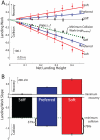Mechanical work as an indirect measure of subjective costs influencing human movement
- PMID: 22383998
- PMCID: PMC3286468
- DOI: 10.1371/journal.pone.0031143
Mechanical work as an indirect measure of subjective costs influencing human movement
Abstract
To descend a flight of stairs, would you rather walk or fall? Falling seems to have some obvious disadvantages such as the risk of pain or injury. But the preferred strategy of walking also entails a cost for the use of active muscles to perform negative work. The amount and distribution of work a person chooses to perform may, therefore, reflect a subjective valuation of the trade-offs between active muscle effort and other costs, such as pain. Here we use a simple jump landing experiment to quantify the work humans prefer to perform to dissipate the energy of landing. We found that healthy normal subjects (N = 8) preferred a strategy that involved performing 37% more negative work than minimally necessary (P<0.001) across a range of landing heights. This then required additional positive work to return to standing rest posture, highlighting the cost of this preference. Subjects were also able to modulate the amount of landing work, and its distribution between active and passive tissues. When instructed to land softly, they performed 76% more work than necessary (P<0.001), with a higher proportion from active muscles (89% vs. 84%, P<0.001). Stiff-legged landings, performed by one subject for demonstration, exhibited close to the minimum of work, with more of it performed passively through soft tissue deformations (at least 30% in stiff landings vs. 16% preferred). During jump landings, humans appear not to minimize muscle work, but instead choose to perform a consistent amount of extra work, presumably to avoid other subjective costs. The degree to which work is not minimized may indirectly quantify the relative valuation of costs that are otherwise difficult to measure.
Conflict of interest statement
Figures






References
-
- Zarrugh MY, Radcliffe CW. Predicting metabolic cost of level walking. European Journal of Applied Physiology and Occupational Physiology. 1978;38:215–223. doi: 10.1007/BF00430080. - DOI - PubMed
-
- Umberger BR, Martin PE. Mechanical power and efficiency of level walking with different stride rates. Journal of Experimental Biology. 2007;210:3255–3265. doi: 10.1242/jeb.000950. - DOI - PubMed
-
- Donelan JM, Kram R, Arthur DK. Mechanical and metabolic determinants of the preferred step width in human walking. Proceedings of the Royal Society of London Series B: Biological Sciences. 2001;268:1985–1992. doi: 10.1098/rspb.2001.1761. - DOI - PMC - PubMed
-
- Gordon KE, Ferris DP, Kuo AD. Metabolic and Mechanical Energy Costs of Reducing Vertical Center of Mass Movement During Gait. Archives of Physical Medicine and Rehabilitation. 2009;90:136–144. doi: 10.1016/j.apmr.2008.07.014. - DOI - PubMed
-
- Bertram JEA, Ruina A. Multiple Walking Speed–frequency Relations are Predicted by Constrained Optimization. Journal of Theoretical Biology. 2001;209:445–453. doi: 10.1006/jtbi.2001.2279. - DOI - PubMed
Publication types
MeSH terms
Grants and funding
LinkOut - more resources
Full Text Sources

